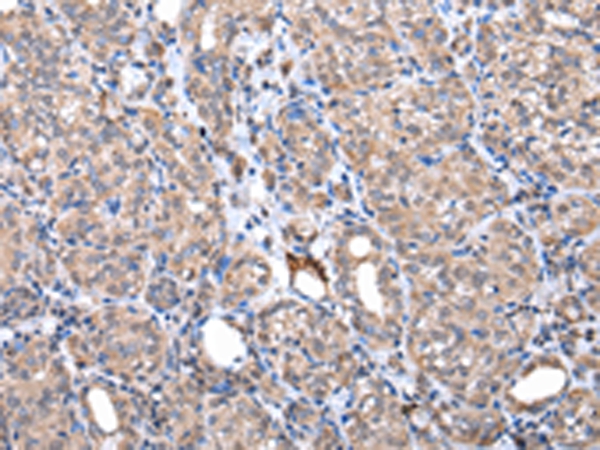
| WB | 咨询技术 | Human,Mouse,Rat |
| IF | 咨询技术 | Human,Mouse,Rat |
| IHC | 1/25-1/100 | Human,Mouse,Rat |
| ICC | 技术咨询 | Human,Mouse,Rat |
| FCM | 咨询技术 | Human,Mouse,Rat |
| Elisa | 咨询技术 | Human,Mouse,Rat |
| Aliases | ZABC1 |
| Entrez GeneID | 7764; |
| Host/Isotype | Rabbit IgG |
| Antibody Type | Primary antibody |
| Storage | Store at 4°C short term. Aliquot and store at -20°C long term. Avoid freeze/thaw cycles. |
| Species Reactivity | Human |
| Immunogen | Fusion protein of human ZNF217 |
| Formulation | Purified antibody in PBS with 0.05% sodium azide. |
+ +
以下是3篇关于ZNF217抗体的参考文献及其摘要概括:
1. **"ZNF217 is a transcriptional repressor that promotes proliferation and epithelial-mesenchymal transition in cancer"**
- **作者**: Thollet, A., et al.
- **摘要**: 该研究通过免疫沉淀和染色质免疫共沉淀(ChIP)实验,利用ZNF217抗体揭示了ZNF217通过抑制抑癌基因(如CDH1)促进上皮间质转化(EMT)和乳腺癌转移,并证明其过表达与患者预后不良相关。
2. **"ZNF217 interacts with the NuRD component MTA1 and contributes to oncogenic transformation"**
- **作者**: Quinlan, K.G., et al.
- **摘要**: 研究使用ZNF217抗体进行Western blot和免疫荧光实验,发现ZNF217与染色质重塑复合体NuRD的组分MTA1相互作用,通过调控致癌信号通路(如PI3K/AKT)促进卵巢癌细胞增殖和化疗耐药性。
3. **"The oncogene ZNF217 modulates aldosterone signaling and cellular responses to hypoxia"**
- **作者**: Vernimmen, D., et al.
- **摘要**: 通过ZNF217抗体在肾上腺皮质癌细胞中的ChIP-seq分析,发现ZNF217通过结合缺氧诱导因子(HIF)靶基因启动子,增强肿瘤细胞在低氧环境下的存活和侵袭能力,提示其作为癌症治疗的潜在靶点。
建议通过PubMed或Google Scholar进一步核实文献细节及获取全文。
The ZNF217 antibody is a crucial tool for studying the zinc finger protein 217 (ZNF217), a transcription factor implicated in oncogenesis and cellular regulation. ZNF217. located on chromosome 20q13. belongs to the Krüppel-associated box (KRAB) zinc finger protein family and functions as a transcriptional repressor by recruiting chromatin-modifying complexes like CoREST/LSD1. It plays a role in pluripotency maintenance, epigenetic silencing, and cancer progression, particularly in promoting epithelial-mesenchymal transition (EMT), metastasis, and resistance to apoptosis. Overexpression of ZNF217 is observed in various cancers, including breast, ovarian, and colorectal cancers, and is often associated with poor prognosis.
ZNF217 antibodies are widely used in research to detect and quantify ZNF217 protein levels via techniques like Western blotting (WB), immunohistochemistry (IHC), and immunofluorescence (IF). These antibodies aid in elucidating ZNF217's interaction networks, DNA-binding activity (e.g., through ChIP-seq), and its role in driving oncogenic pathways. Commercially available ZNF217 antibodies are typically validated for specificity against conserved epitopes, often within its C-terminal zinc finger domains. Recent studies also explore ZNF217's potential as a therapeutic target, emphasizing the antibody's utility in preclinical drug development. However, variability in antibody performance across experimental conditions necessitates careful validation to ensure reproducibility in research applications.
×